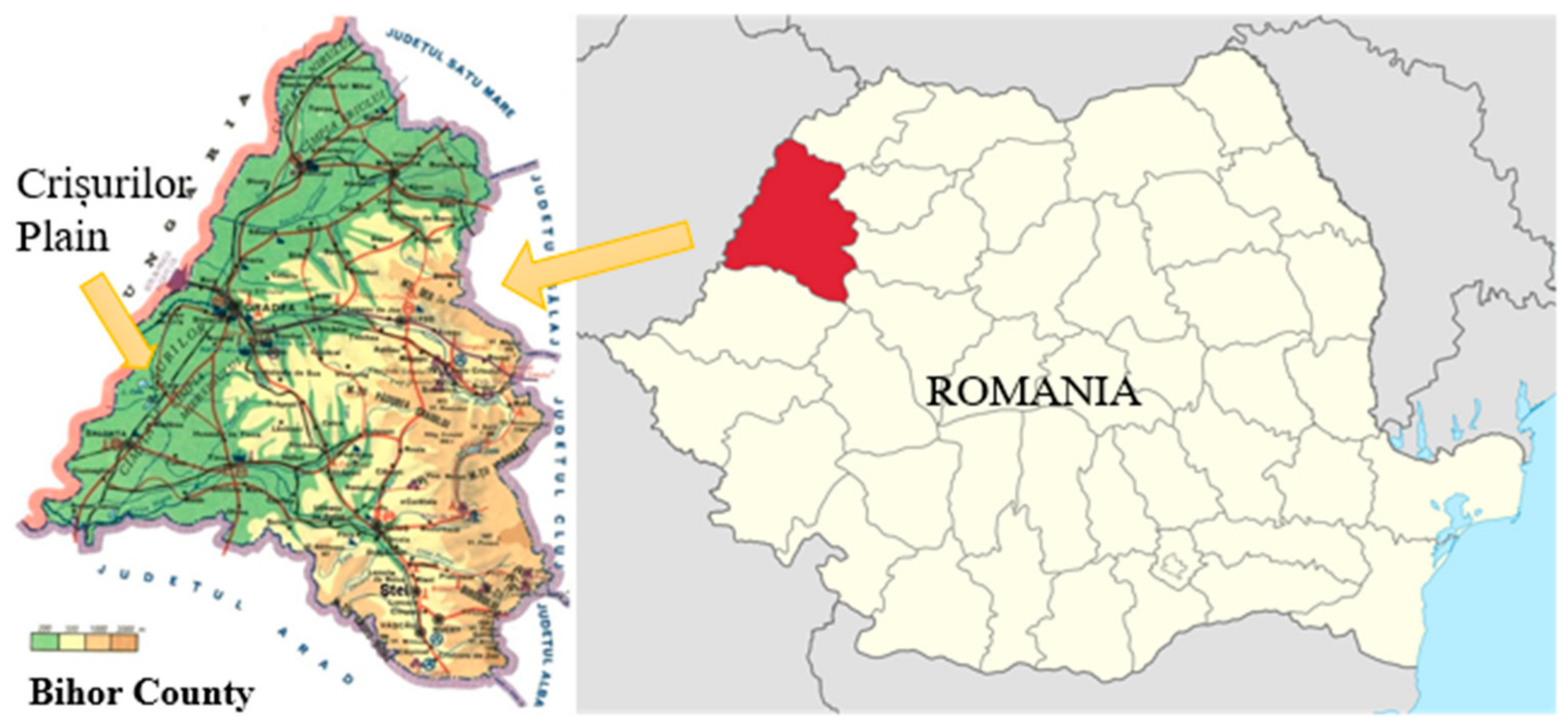Effectiveness of Measures to Reduce the Influence of Global Climate Change on Tomato Cultivation in Solariums—Case Study: Crișurilor Plain, Bihor, Romania
Abstract
:1. Introduction
2. Materials and Methods
2.1. Location of the Experimental Field from Husasău de Tinca, Bihor County
2.2. Water Consumption of Tomatoes Grown in Solariums in Husasău de Tinca
2.3. Irrigation Regime of Tomatoes Grown in Solariums in Husasău de Tinca
2.4. Design of SPAPV from Tomatoes Grown in Solariums at Husasău de Tinca
2.5. Effectiveness of Measures to Reduce the Effects of Climate Change and Energy Consumption
3. Results
3.1. Irrigation Regime of Tomatoes Grown in Solariums
3.2. The Main Characteristics of SPAPV from Tomatoes Grown in Solariums
3.3. The Experimental Field from Husasău de Tinca
3.4. Effectiveness of Measures to Reduce the Effects of Climate Change and Energy Consumption
4. Discussion
4.1. Irrigation Regime of Tomatoes Grown in Solariums
4.2. The Main Characteristics of SPAPV from Tomatoes Grown in Solariums
4.3. The Yields in Experimental Field from Husasău de Tinca
4.4. Effectiveness of Measures to Reduce the Effects of Climate Change and Energy Consumption
5. Conclusions
Author Contributions
Funding
Institutional Review Board Statement
Informed Consent Statement
Data Availability Statement
Acknowledgments
Conflicts of Interest
References
- Xu, J.; Zhu, X.; Li, M.; Qiu, X.; Wang, D.; Xu, Z. Shifts in Dry-Wet Climate Regions over China and Its Related Climate Factors between 1960–1989 and 1990–2019. Sustainability 2022, 14, 719. [Google Scholar] [CrossRef]
- Mizik, T. Climate-Smart Agriculture on Small-Scale Farms: A Systematic Literature Review. Agronomy 2021, 11, 1096. [Google Scholar] [CrossRef]
- Șmuleac, L.; Rujescu, S.; Șmuleac, A.; Imbrea, F.; Radulov, I.; Manea, D.; Ienciu, A.; Adamov, T.; Pașcalau, R. Impact of Climate Change in the Banat Plain, Western Romania, on the Accessibility of Water for Crop Production in Agriculture. Agriculture 2020, 10, 437. [Google Scholar] [CrossRef]
- Dawley, S.; Zhang, Y.; Liu, X.; Jiang, P.; Tick, G.R.; Sun, H.; Zheng, C.; Chen, L. Statistical Analysis of Extreme Events in Precipitation, Stream Discharge, and Groundwater Head Fluctuation: Distribution, Memory, and Correlation. Water 2019, 11, 707. [Google Scholar] [CrossRef] [Green Version]
- Ziernicka-Wojtaszek, A.; Kopcińska, J. Variation in Atmospheric Precipitation in Poland in the Years 2001–2018. Atmosphere 2020, 11, 794. [Google Scholar] [CrossRef]
- Liao, Y.; Chen, D.; Han, Z.; Huang, D. Downscaling of Future Precipitation in China’s Beijing-Tianjin-Hebei Region Using a Weather Generator. Atmosphere 2022, 13, 22. [Google Scholar] [CrossRef]
- Fadl, M.E.; Abuzaid, A.S.; Abdel Rahman, M.A.E.; Biswas, A. Evaluation of Desertification Severity in El-Farafra Oasis, Western Desert of Egypt: Application of Modified MEDALUS Approach Using Wind Erosion Index and Factor Analysis. Land 2022, 11, 54. [Google Scholar] [CrossRef]
- Kaenzig, R.; Piguet, E. Toward a Typology of Displacements in the Context of Slow-Onset Environmental Degradation. An Analysis of Hazards, Policies, and Mobility Patterns. Sustainability 2021, 13, 10235. [Google Scholar] [CrossRef]
- Liu, M.; Guo, Y.; Wang, Y.; Hao, J. Changes of Extreme Agro-Climatic Droughts and Their Impacts on Grain Yields in Rain-Fed Agricultural Regions in China over the Past 50 Years. Atmosphere 2022, 13, 4. [Google Scholar] [CrossRef]
- Koch, M.T.; Pawelzik, E.; Kautz, T. Chloride Changes Soil–Plant Water Relations in Potato (Solanum tuberosum L.). Agronomy 2021, 11, 736. [Google Scholar] [CrossRef]
- Heil, K.; Lehner, A.; Schmidhalter, U. Influence of Climate Conditions on the Temporal Development of Wheat Yields in a Long-Term Experiment in an Area with Pleistocene Loess. Climate 2020, 8, 100. [Google Scholar] [CrossRef]
- Ogunkanmi, L.; MacCarthy, D.S.; Adiku, S.G.K. Impact of Extreme Temperature and Soil Water Stress on the Growth and Yield of Soybean (Glycine max (L.) Merrill). Agriculture 2022, 12, 43. [Google Scholar] [CrossRef]
- Dimitriadou, S.; Nikolakopoulos, K.G. Evapotranspiration Trends and Interactions in Light of the Anthropogenic Footprint and the Climate Crisis: A Review. Hydrology 2021, 8, 163. [Google Scholar] [CrossRef]
- Qaseem, M.F.; Qureshi, R.; Shaheen, H. Effects of Pre-Anthesis Drought, Heat and Their Combination on the Growth, Yield and Physiology of diverse Wheat (Triticum aestivum L.) Genotypes Varying in Sensitivity to Heat and drought stress. Sci. Rep. 2019, 9, 6955. [Google Scholar] [CrossRef] [PubMed] [Green Version]
- Mazhayski, Y.; Pavlov, A.; Miseckaite, O. Crops Water Consumption and Vertical Soil Moisture Exchange. Agrofor Int. J. 2021, 6, 57–64. [Google Scholar] [CrossRef]
- Long, A.; Zhang, P.; Hai, Y.; Deng, X.; Li, J.; Wang, J. Spatio-Temporal Variations of Crop Water Footprint and Its Influencing Factors in Xinjiang, China during 1988–2017. Sustainability 2020, 12, 9678. [Google Scholar] [CrossRef]
- Chaleeraktrakoon, C.; Punyawansiri, S. Impact of Climate Variability and Change on Crop Water Consumption. Adv. Geosci. 2012, 29, 21–29. [Google Scholar] [CrossRef]
- Cho, G.H.; Ahmad, M.J.; Choi, K.-S. Water Supply Reliability of Agricultural Reservoirs under Varying Climate and Rice Farming Practices. Water 2021, 13, 2988. [Google Scholar] [CrossRef]
- Arshad, A.; Zhang, Z.; Zhang, W.; Gujree, I. Long-Term Perspective Changes in Crop Irrigation Requirement Caused by Climate and Agriculture Land Use Changes in Rechna Doab, Pakistan. Water 2019, 11, 1567. [Google Scholar] [CrossRef] [Green Version]
- Saeed, F.H.; Al-Khafaji, M.S.; Al-Faraj, F.A.M. Sensitivity of Irrigation Water Requirement to Climate Change in Arid and Semi-Arid Regions towards Sustainable Management of Water Resources. Sustainability 2021, 13, 13608. [Google Scholar] [CrossRef]
- Cáceres, G.; Millán, P.; Pereira, M.; Lozano, D. Smart Farm Irrigation: Model Predictive Control for Economic Optimal Irrigation in Agriculture. Agronomy 2021, 11, 1810. [Google Scholar] [CrossRef]
- Burlacu, S.; Vasilache, P.C.; Velicu, E.R.; Curea, Ș.-C.; Margina, O. Management of Water Resources at Global Level. In Proceedings of the 3rd International Conference on Economics and Social Sciences, Bucharest, Romania, 15–16 October 2020; pp. 998–1009. [Google Scholar] [CrossRef]
- Rakhecha, P.R. Management of water resources in India. Int. J. Hydro. 2019, 3, 354–360. [Google Scholar] [CrossRef]
- Campi, P.; Navarro, A.; Giglio, L.; Palumbo, A.D.; Mastrorilli, M. Modelling for water supply of irrigated cropping systems on climate change. Ital. J. Agron. 2012, 7, 14. [Google Scholar] [CrossRef] [Green Version]
- Al-Omran, A.; Louki, I.; Alkhasha, A.; Abd El-Wahed, M.H.; Obadi, A. Water Saving and Yield of Potatoes under Partial Root-Zone Drying Drip Irrigation Technique: Field and Modelling Study Using SALTMED Model in Saudi Arabia. Agronomy 2020, 10, 1997. [Google Scholar] [CrossRef]
- Kurbanbaev, S.; Karimova, O.; Turlibaev, Z.; Baymuratov, R. Effective and rational use of irrigation water in the conditions of the republic of Karakalpakstan. In Proceedings of the International Scientific Conference “Construction Mechanics, Hydraulics and Water Resources Engineering” (CONMECHYDRO—2021), Web Conference, 2 June 2021. [Google Scholar] [CrossRef]
- Śpitalniak, M.; Bogacz, A.; Zięba, Z. The Assessment of Water Retention Efficiency of Different Soil Amendments in Comparison to Water Absorbing Geocomposite. Materials 2021, 14, 6658. [Google Scholar] [CrossRef]
- Mugandani, R.; Mwadzingeni, L.; Mafongoya, P. Contribution of Conservation Agriculture to Soil Security. Sustainability 2021, 13, 9857. [Google Scholar] [CrossRef]
- Chowdhury, T.; Chowdhury, H.; Ahmed, A.; Park, Y.-K.; Chowdhury, P.; Hossain, N.; Sait, S.M. Energy, Exergy, and Sustainability Analyses of the Agricultural Sector in Bangladesh. Sustainability 2020, 12, 4447. [Google Scholar] [CrossRef]
- Rokicki, T.; Perkowska, A.; Klepacki, B.; Bórawski, P.; Bełdycka-Bórawska, A.; Michalski, K. Changes in Energy Consumption in Agriculture in the EU Countries. Energies 2021, 14, 1570. [Google Scholar] [CrossRef]
- Nabavi-Pelesaraei, A.; Azadi, H.; Van Passel, A.; Saber, Z.; Hosseini-Fashami, F.; Mostashari-Rad, F.; Ghasemi-Mobtaker, H. Prospects of solar systems in production chain of sunflower oil using cold press method with concentrating energy and life cycle assessment. Energy 2021, 223, 120117. [Google Scholar] [CrossRef]
- Galforda, G.L.; Peñaa, O.; Sullivan, A.K.; Nashab, J.; Gurwick, N.; Pirolli, G.; Richards, M.; White, J.; Wollenberg, E. Agricultural development addresses food loss and waste while reducing greenhouse gas emissions. Sci. Total Environ. 2020, 699, 134318. [Google Scholar] [CrossRef]
- Arodudu, O.; Helming, K.; Wiggering, H.; Voinov, A. Bioenergy from Low-Intensity Agricultural Systems: An Energy Efficiency Analysis. Energies 2017, 10, 29. [Google Scholar] [CrossRef] [Green Version]
- Hossain, J. Wind Energy Resource. In Renewable Energy Engineering and Technology; TERI Press: New Delhi, India, 2021; pp. 445–471. [Google Scholar]
- Ravi, S.; Macknick, J.; Lobell, D.; Fieldd, C.; Ganesan, K.; Jain, R.; Elchinger, M.; Stoltenberg, B. Colocation opportunities for large solar infrastructures and agriculture in drylands. Appl. Energy 2016, 165, 383–392. [Google Scholar] [CrossRef] [Green Version]
- Chazarra-Zapata, J.; Molina-Martínez, J.M.; Cruz, F.J.; Parras-Burgos, D.; Ruíz Canales, A. How to Reduce the Carbon Footprint of an Irrigation Community in the South-East of Spain by Use of Solar Energy. Energies 2020, 13, 2848. [Google Scholar] [CrossRef]
- Bahadori, M.N. Solar water Pumbping. Sol. Energy 1978, 21, 307–316. [Google Scholar] [CrossRef]
- Gopal, C.; Mohanraj, M.; Chandramohan, P.; Chandrasekar, P. Renewablw energy source water pumping systems—A literature review. Renew. Sustain. Energy Rev. 2013, 25, 351–370. [Google Scholar] [CrossRef]
- Bloomberg New Energy Finance (BNEF). Decreasing Production Costs of Solar Panels Arouse the Appetite for Solar Energy. 2016. Available online: https://solarcenter.ro/grafice-care-releva-cresterea-productiei-de-energie-regenerabila/ (accessed on 14 September 2020).
- Closas, A.; Rap, E. Solar-based groundwater pumping for irrigation: Sustainability, policies, and limitations. Energy Policy 2017, 104, 33–37. [Google Scholar] [CrossRef]
- Mahdi, M.M.; Gaddoa, A. An Experimental Study on Optimization of a Photovoltaic Solar Pumping System Used for Solar Domestic Hot Water System under Iraqi Climate. In Intelligent Computing in Engineering. Advances in Intelligent Systems and Computing; Solanki, V., Hoang, M., Lu, Z., Pattnaik, P., Eds.; Springer: Singapore, 2020; 1125p. [Google Scholar] [CrossRef]
- Wazed, S.M.; Hughes, B.R.; O’Connor, D.; Calautit, J.K. Solar Driven Irrigation Systems for Remote Rural Farms. Energy Procedia 2017, 142, 184–191. [Google Scholar] [CrossRef]
- Burneya, J.; Wolteringb, L.; Burkec, M.; Naylora, R.; Pasternak, D. Solar-powered drip irrigation enhances food security in the Sudano–Sahel. Proc. Natl. Acad. Sci. USA 2010, 107, 1848–1853. [Google Scholar] [CrossRef] [Green Version]
- Renu, B.B.; Prasad, B.; Sastry, O.S.; Kumar, A.; Bangar, M. Optimum sizing and performance modeling of Solar Photovoltaic (SPV) water pumps for different climatic conditions. Sol. Energy 2017, 155, 1326–1338. [Google Scholar] [CrossRef]
- Arthishri, K.; Ramalingam, B.; Parkavi, K.; Sishaj, P.S.; Amirtharajan, R. Maximum Power Point Tracking of Photovoltaic Generation System using Artificial Neural Network with Improved Tracking Factor. J. Appl. Sci. 2014, 14, 1858–1864. [Google Scholar] [CrossRef]
- Mokeddema, A.; Midounb, A.; Kadric, D.; Said, H.; Iftikhar, A.R. Performance of a directly-coupled PV water pumping system. Energy Convers. Manag. 2011, 52, 3089–3095. [Google Scholar] [CrossRef]
- Isikwue, M.O.; Ochedikwu Anthea, E.F.; Onoja, S.B. Small Farm Gravity Drip Irrigation System for Crop Production. Greener J. Sci. Eng. Technol. Res. 2016, 6, 48–54. [Google Scholar] [CrossRef]
- Naval, N.; Yusta, J.M. Water-Energy Management for Demand Charges and Energy Cost Optimization of a Pumping Stations System under a Renewable Virtual Power Plant Model. Energies 2020, 13, 2900. [Google Scholar] [CrossRef]
- Yahyaoui, I.; Tadeo, F.; Vieira Segattoa, M. Energy and water management for drip-irrigation of tomatoes in a semi-arid district. Agric. Water Manag. 2017, 183, 4–15. [Google Scholar] [CrossRef]
- Dursun, M.; Ozden, S. Control of soil moisture with radio frequency in a photovoltaic-powered drip irrigation system. Turk. J. Electr. Eng. Comput. Sci. 2015, 23, 447–458. [Google Scholar] [CrossRef]
- Grumeza, N.; Merculiev, O.; Klepș, C. Forecasting and Scheduling the Application of the Watering in Irrigation Systems; CERES Publishing House: Bucharest, Romania, 1989. [Google Scholar]
- El Hafyani, M.; Essahlaoui, A.; Fung-Loy, K.; Hubbart, J.A.; Van Rompaey, A. Assessment of Agricultural Water Requirements for Semi-Arid Areas: A Case Study of the Boufakrane River Watershed (Morocco). Appl. Sci. 2021, 11, 10379. [Google Scholar] [CrossRef]
- Jamshidi, S.; Zand-Parsa, S.; Naghdyzadegan Jahromi, M.; Niyogi, D. Application of A Simple Landsat-MODIS Fusion Model to Estimate Evapotranspiration over A Heterogeneous Sparse Vegetation Region. Remote Sens. 2019, 11, 741. [Google Scholar] [CrossRef] [Green Version]
- Aguilar, A.L.; Flores, H.; Crespo, G.; Marín, M.I.; Campos, I.; Calera, A. Performance Assessment of MOD16 in Evapotranspiration Evaluation in Northwestern Mexico. Water 2018, 10, 901. [Google Scholar] [CrossRef] [Green Version]
- Montazar, A.; Krueger, R.; Corwin, D.; Pourreza, A.; Little, C.; Rios, S.; Snyder, R.L. Determination of Actual Evapotranspiration and Crop Coefficients of California Date Palms Using the Residual of Energy Balance Approach. Water 2020, 12, 2253. [Google Scholar] [CrossRef]
- Xu, C.Y.; Singh, V.P. Evaluation and generalization of temperature-based methods for calculating evaporation. Hydrol. Process 2001, 15, 305–319. [Google Scholar] [CrossRef] [Green Version]
- Singh, Y.P.; Paradkar, V.D.; Sharma, V.; Kour, M. Calculation of Reference Evapotranspiration (ET0) for Chhattisgarh Plains. Ind. J. Pure App. Biosci. 2019, 7, 401–405. [Google Scholar] [CrossRef]
- Tigkas, D.; Vangelis HTsakiris, G. Implementing Crop Evapotranspiration in RDI for Farm-Level Drought Evaluation and Adaptation under Climate Change Conditions. Water Resour. Manag. 2020, 34, 4329–4343. [Google Scholar] [CrossRef]
- Buttaro, D.; Santamaria, P.; Signore, A.; Cantore, V.; Boari, F.; Montesano, F.F.; Parente, A. Irrigation Management of Greenhouse Tomato and Cucumber Using Tensiometer: Effects on Yield, Quality and Water Use. Agric. Agric. Sci. Procedia 2015, 4, 440–444. [Google Scholar] [CrossRef] [Green Version]
- Jing, L.; Haorui, C. Conjunctive use of groundwater and surface water for paddy rice irrigation in Sanjiang plain, North-East China. Irrig. Drain. 2020, 69, 142–152. [Google Scholar] [CrossRef]
- Aydın, Y. Assessing of evapotranspiration models using limited climatic data in Southeast Anatolian Project Region of Turkey. PeerJ 2021, 9, e11571. [Google Scholar] [CrossRef] [PubMed]
- Song, X.; Miao, L.; Jiao, X.; Ibrahim, M.; Li, J. Regulating Vapor Pressure Deficit and Soil Moisture Improves Tomato and Cucumber Plant Growth and Water Productivity in the Greenhouse. Horticulturae 2022, 8, 147. [Google Scholar] [CrossRef]
- Muhammad, M.K.I.; Nashwan, M.S.; Shahid, S.; Ismail, T.b.; Song, Y.H.; Chung, E.-S. Evaluation of Empirical Reference Evapotranspiration Models Using Compromise Programming: A Case Study of Peninsular Malaysia. Sustainability 2019, 11, 4267. [Google Scholar] [CrossRef] [Green Version]
- Thaís, G.M.; da Silva, M.B.; de Pires, M.R.C.; Souza, C.F. Deficit irrigation of subsurface drip-irrigated grape tomato. Eng. Agríc. 2020, 40, 53–461. [Google Scholar] [CrossRef]
- Distretto di Bihor -Wikipedia. Available online: https://it.wikipedia.org/wiki/Distretto_di_Bihor#/media/File:Bihor_in_Romania.svg (accessed on 14 January 2022).
- Bihor County Map of Romania. Available online: https://pe-harta.ro/bihor/ (accessed on 14 January 2022).
- National Meteorological Agency. Available online: http://www.meteoromania.ro/ (accessed on 20 February 2020).
- Ardelean, M.; Sestraș, T.; Cordea, M. Experimental Horticultural Technique; Academicpres Publishing House: Cluj-Napoca, Romania, 2005; p. 110. [Google Scholar]
- Ciupak, M.; Ozga-Zieliński, B.; Tokarczyk, T.; Adamowski, J. A Probabilistic Model for Maximum Rainfall Frequency Analysis. Water 2021, 13, 2688. [Google Scholar] [CrossRef]
- Domuţa, C.; Cărbunaru, M.; Şandor, M.; Bandici, G.; Samuel, A.; Stanciu, A.; Domuţa, C. Use of the Piche evaporimeter in the irrigation sheduling of the tomatoes in the conditions from the solarium. Ann. Univ. Oradea Fascicle Environ. Prot. 2007, XII, 40–45. [Google Scholar]
- Thornthwaite, C.W. An approach toward a rational classification of climate. Geogr. Rev. 1948, 38, 55–94. [Google Scholar] [CrossRef]
- Tigkas, D.; Vangelis, H.; Tsakiris, G. Drought characterisation based on an agriculture-oriented standardised precipitation index. Theor. Appl. Climatol. 2019, 135, 1435–1447. [Google Scholar] [CrossRef]
- Zheng, S.; Ni, K.; Ji, L.; Zhao, C.; Chai, H.; Yi, X.; He, W.; Ruan, J. Estimation of Evapotranspiration and Crop Coefficient of Rain-Fed Tea Plants under a Subtropical Climate. Agronomy 2021, 11, 2332. [Google Scholar] [CrossRef]
- Cărbunar, M. Contributions to the Study of SOIL mulching and Drip Irrigation to the Cultivation of Tomatoes in Solariums Covered with Long-Lasting Foils. Ph.D. Thesis, USAMV, Cluj-Napoca, Romania, 2005. [Google Scholar]
- Hanping, M.; Ullah, I.; Jiheng, N.; Javed, Q.; Azeem, A. Estimating tomato water consumption by sap flow measurement in response to water stress under greenhouse conditions. J. Plant Interact. 2017, 12, 402–413. [Google Scholar] [CrossRef]
- Chand, J.; Hewa, G.; Hassanli, A.; Myers, B. Evaluation of Deficit Irrigation and Water Quality on Production and Water Productivity of Tomato in Greenhouse. Agriculture 2020, 10, 297. [Google Scholar] [CrossRef]
- Tanaskovik, V.; Cukaliev, O.; Markoski, M.; Mitkova, T.; Vukelic Shutoska, M. Soil Moisture Dynamics in Different Irrigation Regimes of Tomato Crop. Agric. For. 2016, 62, 415–429. [Google Scholar] [CrossRef] [Green Version]
- Sharu, E.H.; Ab Razak, M.S. Hydraulic Performance and Modelling of Pressurized Drip Irrigation System. Water 2020, 12, 2295. [Google Scholar] [CrossRef]
- Calero-Lara, M.; López-Luque, R.; Casares, F.J. Methodological Advances in the Design of Photovoltaic Irrigation. Agronomy 2021, 11, 2313. [Google Scholar] [CrossRef]
- Lorentz. Solar-Powered Water Pumping for Irrigation. 2022. Available online: https://www.lorentz.de/solutions/applications/irrigation/ (accessed on 26 February 2022).
- Lorentz. PS 600 BADU Top 12, Solar Operated Centrifugal Surface Pump. 2019. Available online: http://client.lpelectric.ro/doc/lorentz_ps600_badutop.pdf (accessed on 21 May 2021).
- Paulescu, M.; Schlett, Z. A simplified but accurate spectral solar irradiance model. Theor. Appl. Climatol. 2003, 75, 203–212. [Google Scholar] [CrossRef]
- European Comision. Phoytovoltaic Geographical Information System (PVGIS). 2021. Available online: https://re.jrc.ec.europa.eu/pvg_tools/en/#TMY (accessed on 14 May 2021).
- Paulescu, M.; Paulescu, E.; Gavrilă, P.; Bădescu, V. Weather Modeling and Forecasting of PV Systems Operation; Springer: London, UK, 2013. [Google Scholar]
- Victron Energy. BlueSolar Monocrystalline Panels. 2020. Available online: https://www.victronenergy.com/upload/documents/Datasheet-BlueSolar-Monocrystalline-Panels-EN.pdf (accessed on 27 March 2021).
- Tamesol. Energia Para Vivir. 2020. Available online: https://www.empresia.es/distintivo/tamesol-energia-para-vivir/oepm/m-3657250/ (accessed on 26 February 2022).
- SunPower. Solar Panel, SGSP Series. 2016. Available online: https://www.sungoldsolar.com/Rigid-Solar-Panel-SGSP-series.html (accessed on 24 March 2021).
- ENF. Solar Trade Platform and Directory of Solar Companies. 2019. Available online: https://www.enfsolar.com/pv/panel-datasheet/crystalline/1574 (accessed on 26 February 2022).
- AE Solar. Product List. 2020. Available online: https://catalog.climatherm.ro/energii-regenerabile/sisteme-fotovoltaice/panou-fotovoltaic/panou-320w (accessed on 30 March 2020).
- Crespo Chacón, M.; Rodríguez Díaz, J.A.; García Morillo, J.; McNabola, A. Pump-as-Turbine Selection Methodology for Energy Recovery in Irrigation Networks: Minimising the Payback Period. Water 2019, 11, 149. [Google Scholar] [CrossRef] [Green Version]
- Jayathilaka, A.K.K.R. Operating Profit and Net Profit: Measurements of Profitability. Open Access Libr. J. 2020, 7, e7011. [Google Scholar] [CrossRef]
- Li, X.; Jiang, W.; Duan, D. Spatio-temporal analysis of irrigation water use coefficients in China. J. Environ. Manag. 2020, 262, 110242. [Google Scholar] [CrossRef] [PubMed]
- Pinnamaneni, S.R.; Anapalli, S.S.; Fisher, D.K.; Reddy, K.N. Water Use Efficiencies of Different Maturity Group Soybean Cultivars in the Humid Mississippi Delta. Water 2021, 13, 1496. [Google Scholar] [CrossRef]
- Li, X.; Ma, J.; Zheng, L.; Chen, J.; Sun, X.; Guo, X. Optimization of the Regulated Deficit Irrigation Strategy for Greenhouse Tomato Based on the Fuzzy Borda Model. Agriculture 2022, 12, 324. [Google Scholar] [CrossRef]
- Màtè, M.D.; Szalòkinè Zima, I. Development and yield of field tomato under different water supply. Res. J. Agric. Sci. 2020, 52, 167–177. [Google Scholar]
- Dîrja, M.; Budiu, V.; Păcurar, I.; Jurian, M. Research regarding the water consumption of tomatoes, green pepper and cucumbers cultivated in solariums. J. Cent. Eur. Agric. 2003, 4, 265–272. [Google Scholar]
- Cervera-Gascó, J.; Perea, R.G.; Montero, J.; Moreno, M.A. Prediction Model of Photovoltaic Power in Solar Pumping Systems Based on Artificial Intelligence. Agronomy 2022, 12, 693. [Google Scholar] [CrossRef]
- Ehsan, E.; Zainab, K.; Zhixin, Z. Understanding farmers’ intention and willingness to install renewable energy technology: A solution to reduce the environmental emissions of agriculture. Appl. Energy 2022, 309, 118459. [Google Scholar] [CrossRef]
- Mendonça, S.R.; Alvila, M.C.R.; Vital, R.G.; Evangelista, R.Z.; de Carvalho Pontes, N.; dos Reis Nascimento, A. The effect of different mulching on tomato development and yield. Sci. Hortic. 2021, 275, 109657. [Google Scholar] [CrossRef]
- Li, Y.; Zhang, Z.; Wang, J.; Zhang, M. Soil Aeration and Plastic Film Mulching Increase the Yield Potential and Quality of Tomato (Solanum lycopersicum). Agriculture 2022, 12, 269. [Google Scholar] [CrossRef]
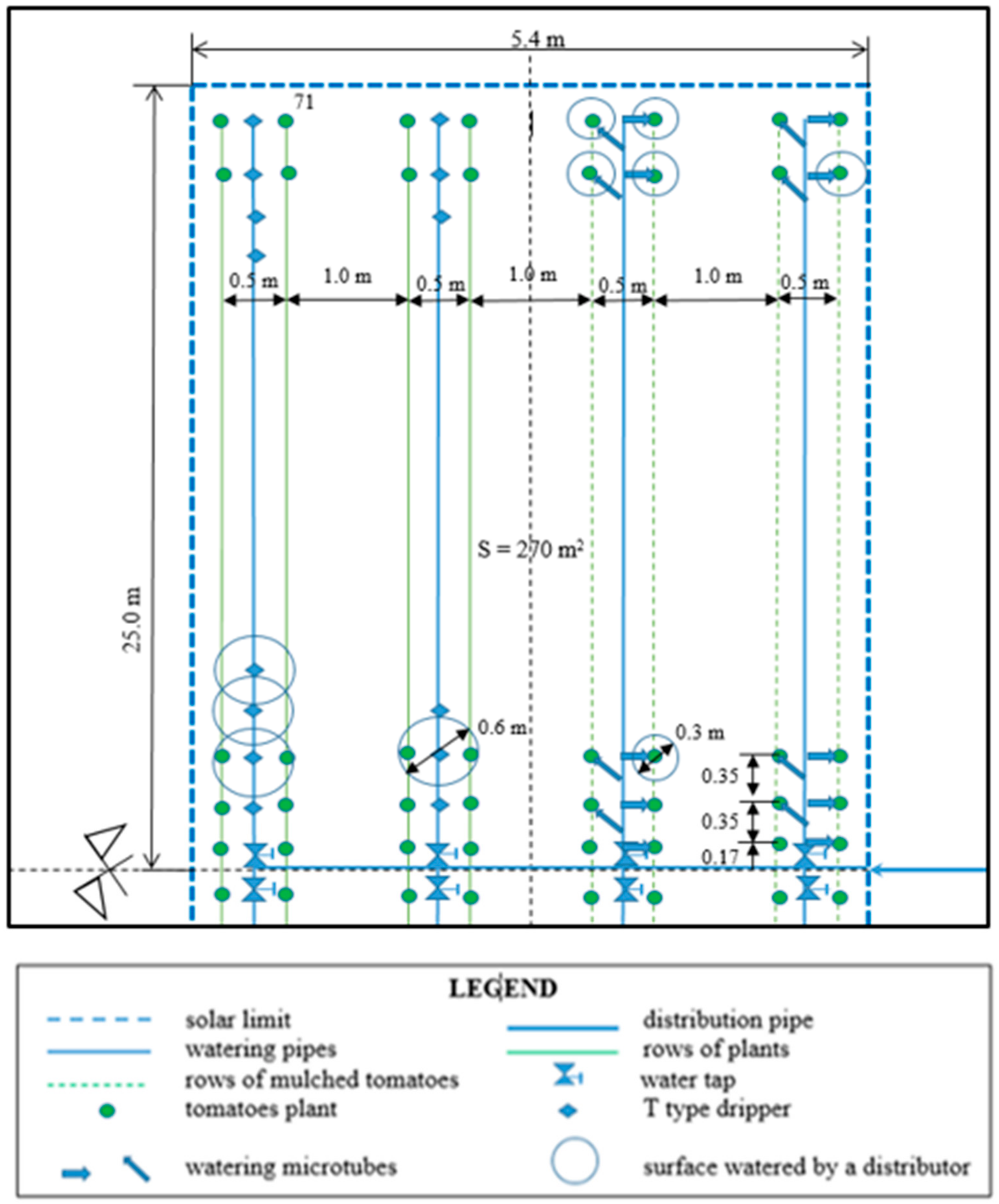

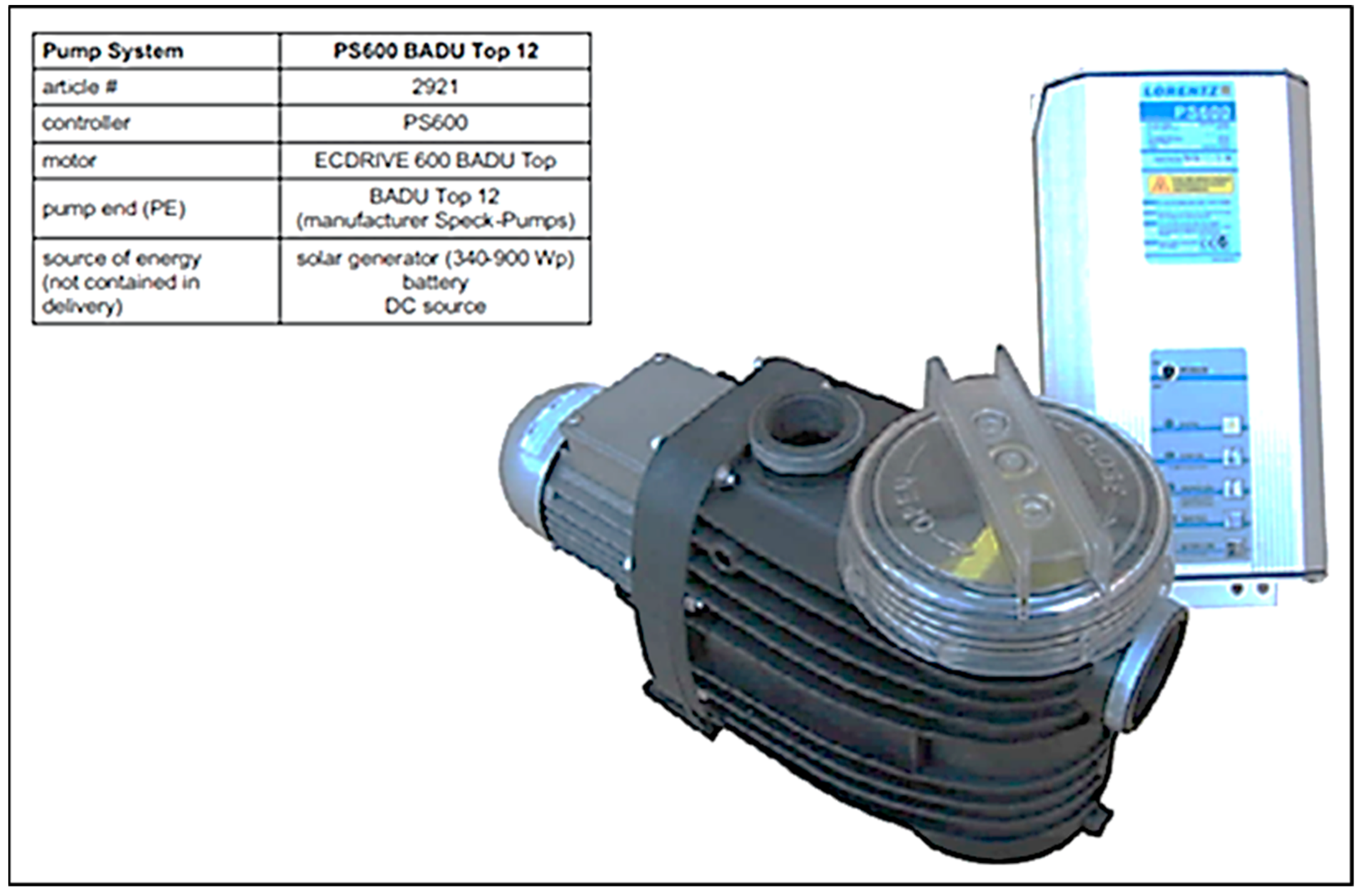
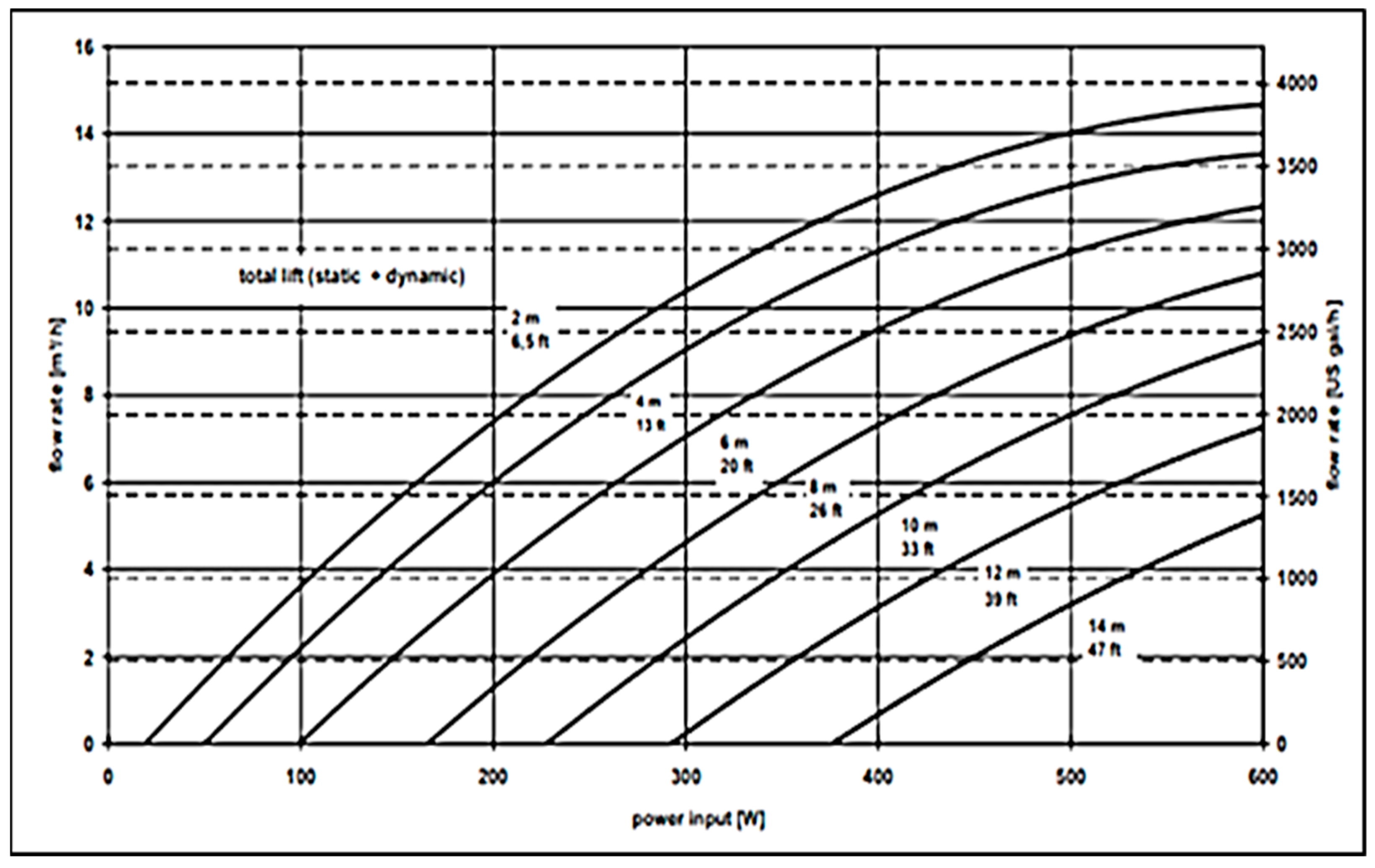
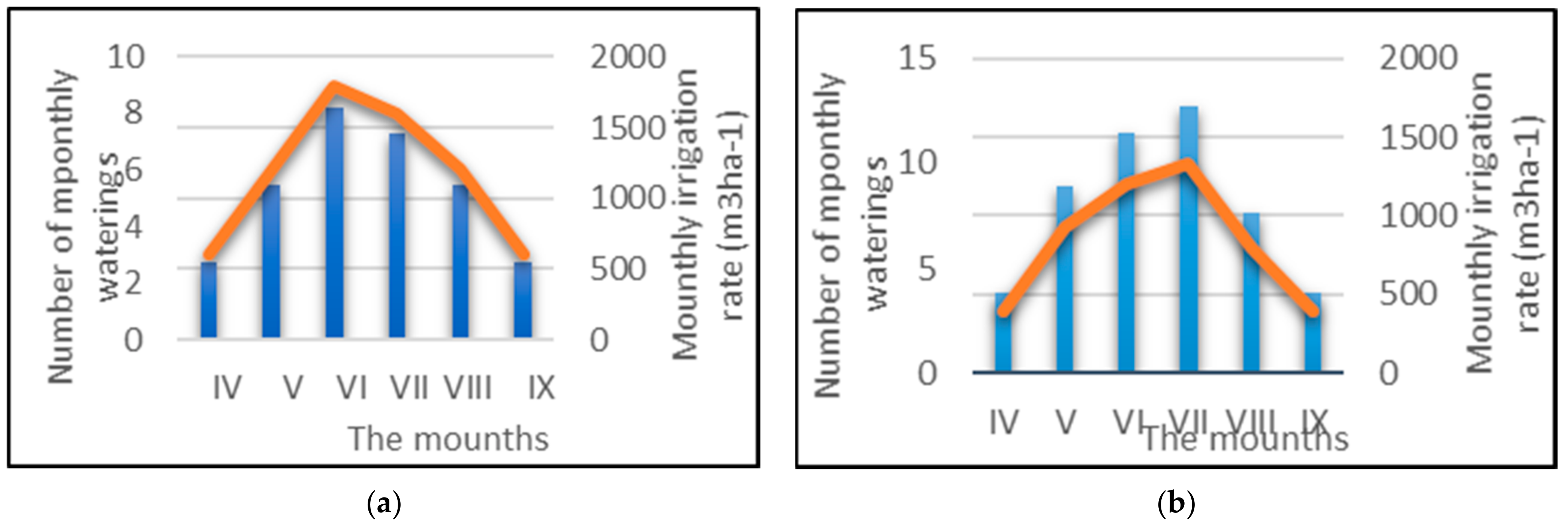
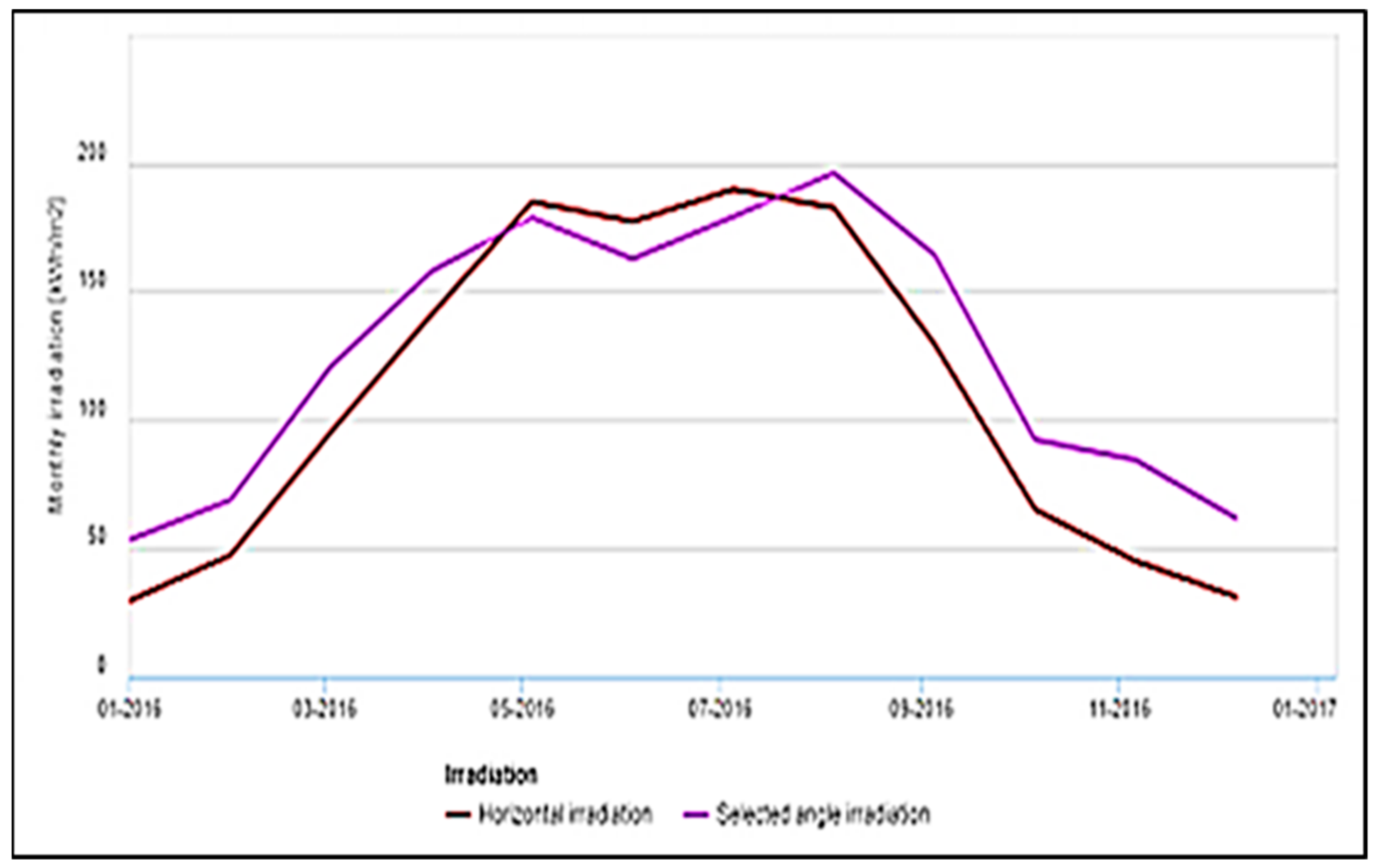
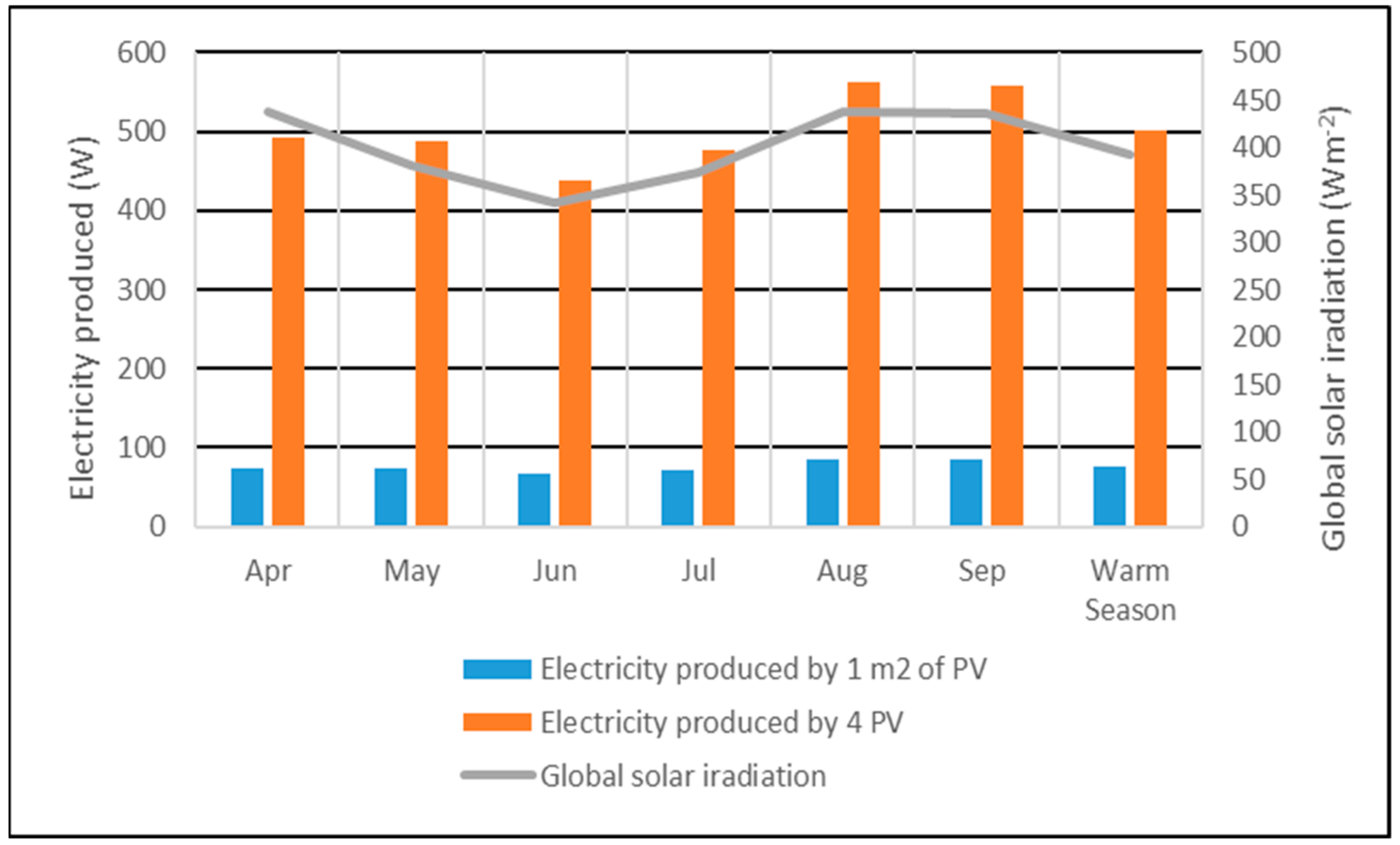
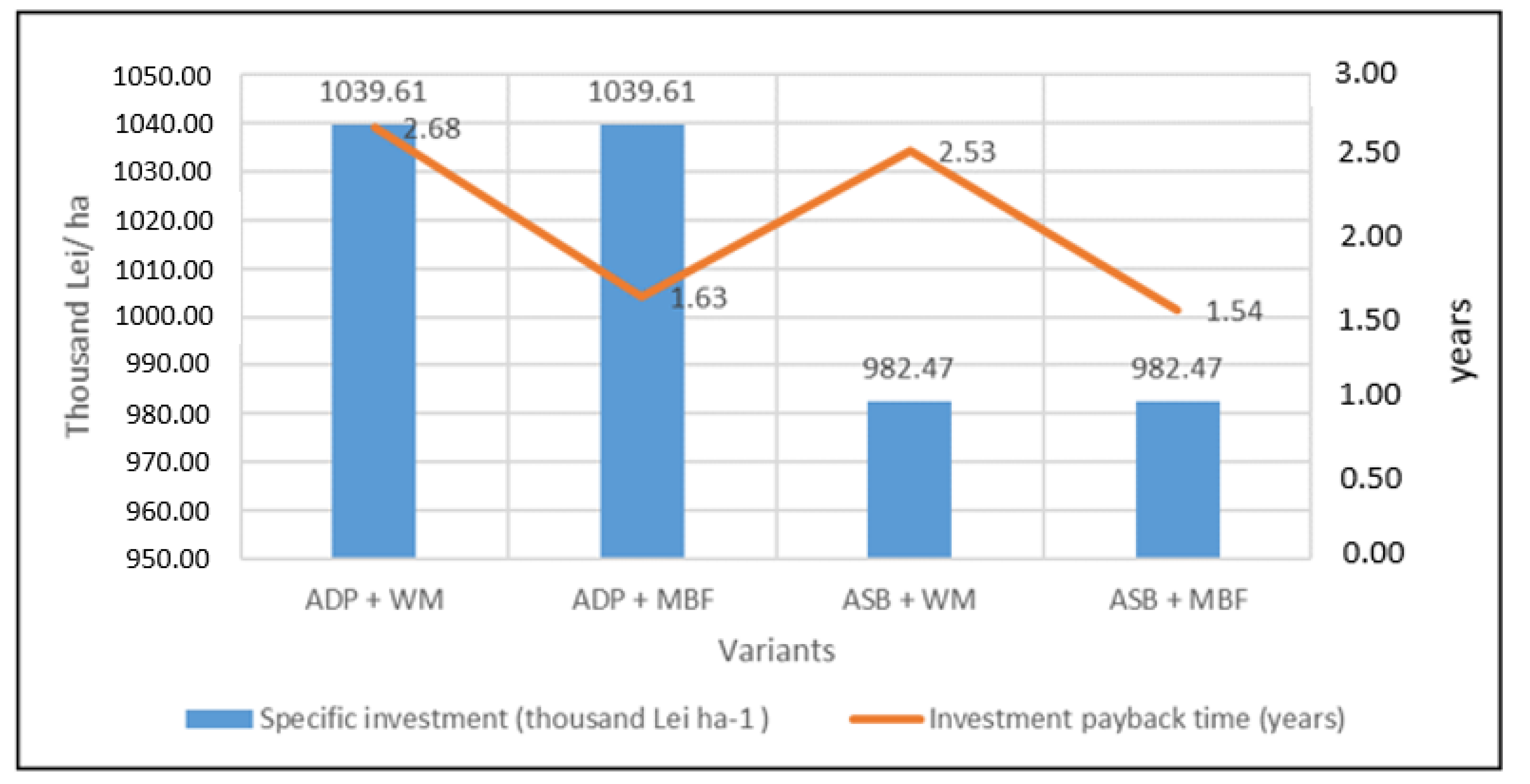
| Latitude | Longitude | Altitude (m) | |
|---|---|---|---|
| Husasău de Tinca | 46°49′10″ N | 21°54′39″ E | 134 |
| Oradea | 47°02′20″ N | 21°53′58″ E | 132 |
| Climatic Data | Number of Agricultural Years | MEAN | MIN | MAX | STDEV * | MSE ** |
|---|---|---|---|---|---|---|
| Rainfall (mm) | 48 | 620.0 | 411.0 | 889.8 | 120.3 | 17.4 |
| Air temperature (°C) | 48 | 10.70 | 8.90 | 12.45 | 1.23 | 0.03 |
| Relative humidity (%) | 48 | 76.68 | 67.50 | 83.58 | 3.61 | 0.52 |
| Speed of wind (ms−1) | 48 | 2.93 | 2.40 | 3.60 | 0.30 | 0.04 |
| Number of sunny days | 48 | 296.56 | 271.00 | 321.00 | 10.88 | 1.57 |
| Duration of sunlight (h) | 48 | 2104.43 | 1814.4 | 2535.2 | 139.24 | 20.1 |
| Manufacturer | Type | Pumping Height (MWC) | Debit (m3 h−1) | Rated Power (kW) | Reference |
|---|---|---|---|---|---|
| Lorentz | PS 2-600CS-17-1 | 12 | 18 | 0.7 | [80] |
| Lorentz | PS2-1800CS-37-1 | 14 | 36 | 1.8 | [80] |
| Lorentz | PS-150 BOOST-330 | 50 | 1.3 | 0.3 | [80] |
| Lorentz | PS600 BADU Top12 | 4 | 10 | 0.5 | [81] |
| Trade Name | Manufacturer | Type * | Surface (m2) | Power (W) | Efficiency (%) | Source |
|---|---|---|---|---|---|---|
| SPM041751200 | Victorian Energy, The Netherlands | M | 0.99 | 175 | 13.0 | [85] |
| TM-P660265 | Tamesol, Girona, Spain | P | 1.46 | 265 | 14.4 | [86] |
| SGSP-150 | Sun Power, Shenzhen, China | M | 0.78 | 150 | 22.6 | [87] |
| FVG-185M-MC | FVG Energy, Cittadella, Italy | M | 1.28 | 185 | 14.5 | [88] |
| AE320M6-60 | AE Solar, Königsbrum, Germany | M | 1.66 | 320 | 19.3 | [89] |
| Specification | U.M. | Vegetation Period | Average Sum | |||||
|---|---|---|---|---|---|---|---|---|
| April | May | June | July | August | September | |||
| Air temperature Oradea (Ta) | °C | 13.4 | 16.4 | 21.3 | 22.5 | 21.1 | 18.0 | 18.8 |
| Air temperature inside solarium (Ti) | °C | 18.1 | 20.7 | 25.0 | 26.1 | 24.8 | 22.1 | 22.8 |
| Potential Evapotranspiration inside solarium (PET) | mm month−1 | 75.31 | 110.37 | 157.73 | 171.46 | 143.80 | 99.34 | 7580.01 |
| m3 ha−1 | 753.1 | 1103.7 | 1577.3 | 1714.6 | 1438.0 | 993.4 | 75,800.1 | |
| The culture coefficient (Kc) WM variant | 1.01 | 1.03 | 1.02 | 1.03 | 0.77 | 0.57 | 0.819 | |
| The culture coefficient (Kc) MBF variant | 1.00 | 1.02 | 1.00 | 0.96 | 0.72 | 0.55 | 0.875 | |
| Optimal actual evapotranspiration (ETRo) WM variant | m3 ha−1 | 760.6 | 1136.8 | 1608.8 | 1766.0 | 1107.3 | 566.2 | 6945.7 |
| m3 ha−1 day−1 | 25.35 | 36.67 | 53.63 | 46.97 | 35.72 | 18.87 | 217.21 | |
| mm day−1 | 25.4 | 36.7 | 53.6 | 47.0 | 35.7 | 18.9 | 217.3 | |
| Optimal actual evapotranspiration (ETRo) MBF variant | m3 ha−1 | 753.1 | 1125.8 | 1577.3 | 1646.0 | 1035.4 | 546.4 | 6594.0 |
| m3 ha−1 day−1 | 25.10 | 36.32 | 52.28 | 53.10 | 33.40 | 18.21 | 215.41 | |
| mm day−1 | 25.1 | 36.3 | 52.6 | 53.1 | 33.4 | 18.2 | 218.7 | |
| Specification | Depth H (m) | Bulk Density BD (g cm−3) | FC-MC (%) | Percentage of Watered Area P/100 | Watering Efficiency η | Watering Norm (m) | ||
|---|---|---|---|---|---|---|---|---|
| m3 ha−1 | L m−2 | L Plant−1 | ||||||
| WM variant | 0.50 | 1.48 | 4.8 | 0.436 | 0.85 | 182 | 18.2 | 3.2 |
| MBF variant | 0.50 | 1.48 | 4.8 | 0.405 | 0.85 | 182 | 16.9 | 3.0 |
| Months | Without Mulching (WM) | Mulched with Black Foil (MBF) | ||||||
|---|---|---|---|---|---|---|---|---|
| Data | n | m | Σm | Data | n | m | Σm | |
| April | 14, 22, 29 | 3 | 182 | 546 | 14, 20, 27 | 3 | 169 | 507 |
| May | 4, 9, 14, 19, 24, 29 | 6 | 182 | 1092 | 3, 7, 12, 16, 21, 26, 30 | 7 | 169 | 1183 |
| June | 2, 5, 9, 12, 15, 18, 22, 26, 30 | 9 | 182 | 1638 | 3, 6, 9, 12, 16, 19, 22, 25, 28 | 9 | 169 | 1521 |
| July | 3, 7, 10, 14, 18, 22, 26, 30 | 8 | 182 | 1456 | 2, 5, 8, 11, 14, 17, 21, 24, 27, 30 | 10 | 169 | 1690 |
| August | 4, 9, 14, 19, 24, 29 | 6 | 182 | 1092 | 4, 9, 14, 19, 24, 29 | 6 | 169 | 1014 |
| September | 7, 16, 26 | 3 | 182 | 546 | 7, 16, 25 | 3 | 169 | 507 |
| TOTAL | 35 | 6370 | 38 | 6422 | ||||
| Specification | April | May | June | July | August | September | Warm Season | Annual |
|---|---|---|---|---|---|---|---|---|
| Monthly solar irradiation—H (kWh m−2) | 157.9 | 178.7 | 162.7 | 162.9 | 196.2 | 164.3 | 1038.9 | 1641.4 |
| Daily solar irradiation—(kWh m−2) | 5.263 | 5.765 | 5.423 | 5.777 | 6.213 | 5.477 | 5.677 | 4.485 |
| Solar day (h) | 13.70 | 8.54 | 8.17 | 9.82 | 9.87 | 7.70 | 8.62 | 7.07 |
| Average duration of sunlight (h) | 7.36 | 8.54 | 8.17 | 9.82 | 9.87 | 7.70 | 8.62 | 7.07 |
| Hourly global solar irradiation—H (W m−2) | 384.2 | 380.8 | 342.4 | 372.7 | 438.2 | 435.4 | 391.8 | 365.2 |
| Variant | Month | Pumped Flow | n | m | Duration of Sunlight | Operating Time of Water Dispensers | Number of Irrigated Solariums | |
|---|---|---|---|---|---|---|---|---|
| m3 h−1 | L h−1 | L m−2 | h | h | ||||
| WM | April | 12.7 | 12,700 | 3 | 18.2 | 7.36 | 4 | 1.84 |
| May | 12.5 | 12,500 | 6 | 18.2 | 8.54 | 4 | 2.14 | |
| June | 11.9 | 11,900 | 9 | 18.2 | 8.17 | 4 | 2.04 | |
| July | 12.3 | 12,300 | 8 | 18.2 | 9.82 | 4 | 2.46 | |
| August | 13.3 | 13,300 | 6 | 18.2 | 9.87 | 4 | 2.47 | |
| September | 13.2 | 13,200 | 3 | 18.2 | 7.70 | 4 | 1.93 | |
| MBF | April | 12.7 | 12,700 | 3 | 16.9 | 7.36 | 6 | 1.23 |
| May | 12.5 | 12,500 | 7 | 16.9 | 8.54 | 6 | 1.42 | |
| June | 11.9 | 11,900 | 9 | 16.9 | 8.17 | 6 | 1.36 | |
| July | 12.3 | 12,300 | 10 | 16.9 | 9.82 | 6 | 1.64 | |
| August | 13.3 | 13,300 | 6 | 16.9 | 9.87 | 6 | 1.65 | |
| September | 13.2 | 13,200 | 3 | 16.9 | 7.70 | 6 | 1.28 | |
| Variant | Month | Pumped Flow | n | m for a Solarium | Duration of Sunlight | Volume of Pumped Water | Number of Irrigated Solariums | |
|---|---|---|---|---|---|---|---|---|
| m3 h−1 | L h−1 | m3 | h | m3 Day−1 | ||||
| WM | April | 12.7 | 12,700 | 3 | 45.5 | 7.36 | 93.5 | 2.05 |
| May | 12.5 | 12,500 | 6 | 45.5 | 8.54 | 106.8 | 2.34 | |
| June | 11.9 | 11,900 | 9 | 45.5 | 8.17 | 97.2 | 2.14 | |
| July | 12.3 | 12,300 | 8 | 45.5 | 9.82 | 120.8 | 2.65 | |
| August | 13.3 | 13,300 | 6 | 45.5 | 9.87 | 131.3 | 2.88 | |
| September | 13.2 | 13,200 | 3 | 45.5 | 7.70 | 101.6 | 2.23 | |
| MBF | April | 12.7 | 12,700 | 3 | 42.25 | 7.36 | 93.5 | 2.21 |
| May | 12.5 | 12,500 | 7 | 42.25 | 8.54 | 106.8 | 2.53 | |
| June | 11.9 | 11,900 | 9 | 42.25 | 8.17 | 97.2 | 2.30 | |
| July | 12.3 | 12,300 | 10 | 42.25 | 9.82 | 120.8 | 2.86 | |
| August | 13.3 | 13,300 | 6 | 42.25 | 9.87 | 131.3 | 3.11 | |
| September | 13.2 | 13,200 | 3 | 42.25 | 7.70 | 101.6 | 2.40 | |
| Variants | Years | Average (2015–2017) | ||||||||||||||
|---|---|---|---|---|---|---|---|---|---|---|---|---|---|---|---|---|
| 2015 | 2016 | 2017 | ||||||||||||||
| T ha−1 | % | ± | Sign | T ha−1 | % | ± | Sign | T ha−1 | % | ± | Sign | T ha−1 | % | ± | Sign | |
| WM | 84.63 | 100.00 | - | - | 87.97 | 100.00 | - | - | 87.23 | 100.00 | - | - | 86.61 | 100.00 | - | - |
| MBF | 113.60 | 134.24 | 28.97 | *** | 112.03 | 127.35 | 24.06 | *** | 111.72 | 128.08 | 24.49 | *** | 112.45 | 129.83 | 25.84 | *** |
| Fischer test (F) | ||||||||||||||||
| F 5% | 5.79 | FC 1 = | 2503 | 5.79 | FC 1 = | 1472 | 5.79 | FC 1 = | 713.8 | 3.55 | FC 1 = | 175.9 | ||||
| F 1% | 10.92 | 10.92 | 10.92 | 6.01 | ||||||||||||
| Student test (t) | ||||||||||||||||
| LSD 2 5% | 0.685 | 0.832 | 1.882 | 0.971 | ||||||||||||
| LSD 2 1% | 1.037 | 1.260 | 2.850 | 1.323 | ||||||||||||
| LSD 2 0.1% | 1.667 | 2.024 | 4.579 | 1.813 | ||||||||||||
| Variant | ETRo | Σm | Y | WUC (ETRo/Y) | WUE (Y/ETRo) | IWUC (Σm/Y) | IWUE (Y/Σm) |
|---|---|---|---|---|---|---|---|
| M3 ha−1 | M3 ha−1 | Kg ha−1 | M3 kg−1 | Kg m−3 | M3 kg−1 | Kg m−3 | |
| WM | 6945.7 | 6370 | 87,970 | 0.079 | 12.67 | 0.072 | 13.81 |
| MBF | 6594.0 | 6422 | 112,030 | 0.059 | 16.99 | 0.057 | 17.44 |
| Differences | +0.02 | −4.32 | +0.015 | −3.63 |
Publisher’s Note: MDPI stays neutral with regard to jurisdictional claims in published maps and institutional affiliations. |
© 2022 by the authors. Licensee MDPI, Basel, Switzerland. This article is an open access article distributed under the terms and conditions of the Creative Commons Attribution (CC BY) license (https://creativecommons.org/licenses/by/4.0/).
Share and Cite
Cărbunar, M.; Mintaș, O.; Sabău, N.C.; Borza, I.; Stanciu, A.; Pereș, A.; Venig, A.; Curilă, M.; Cărbunar, M.L.; Vidican, T.; et al. Effectiveness of Measures to Reduce the Influence of Global Climate Change on Tomato Cultivation in Solariums—Case Study: Crișurilor Plain, Bihor, Romania. Agriculture 2022, 12, 634. https://doi.org/10.3390/agriculture12050634
Cărbunar M, Mintaș O, Sabău NC, Borza I, Stanciu A, Pereș A, Venig A, Curilă M, Cărbunar ML, Vidican T, et al. Effectiveness of Measures to Reduce the Influence of Global Climate Change on Tomato Cultivation in Solariums—Case Study: Crișurilor Plain, Bihor, Romania. Agriculture. 2022; 12(5):634. https://doi.org/10.3390/agriculture12050634
Chicago/Turabian StyleCărbunar, Mihai, Olimpia Mintaș, Nicu Cornel Sabău, Ioana Borza, Alina Stanciu, Ana Pereș, Adelina Venig, Mircea Curilă, Mihaela Lavinia Cărbunar, Teodora Vidican, and et al. 2022. "Effectiveness of Measures to Reduce the Influence of Global Climate Change on Tomato Cultivation in Solariums—Case Study: Crișurilor Plain, Bihor, Romania" Agriculture 12, no. 5: 634. https://doi.org/10.3390/agriculture12050634
APA StyleCărbunar, M., Mintaș, O., Sabău, N. C., Borza, I., Stanciu, A., Pereș, A., Venig, A., Curilă, M., Cărbunar, M. L., Vidican, T., & Oneț, C. (2022). Effectiveness of Measures to Reduce the Influence of Global Climate Change on Tomato Cultivation in Solariums—Case Study: Crișurilor Plain, Bihor, Romania. Agriculture, 12(5), 634. https://doi.org/10.3390/agriculture12050634







